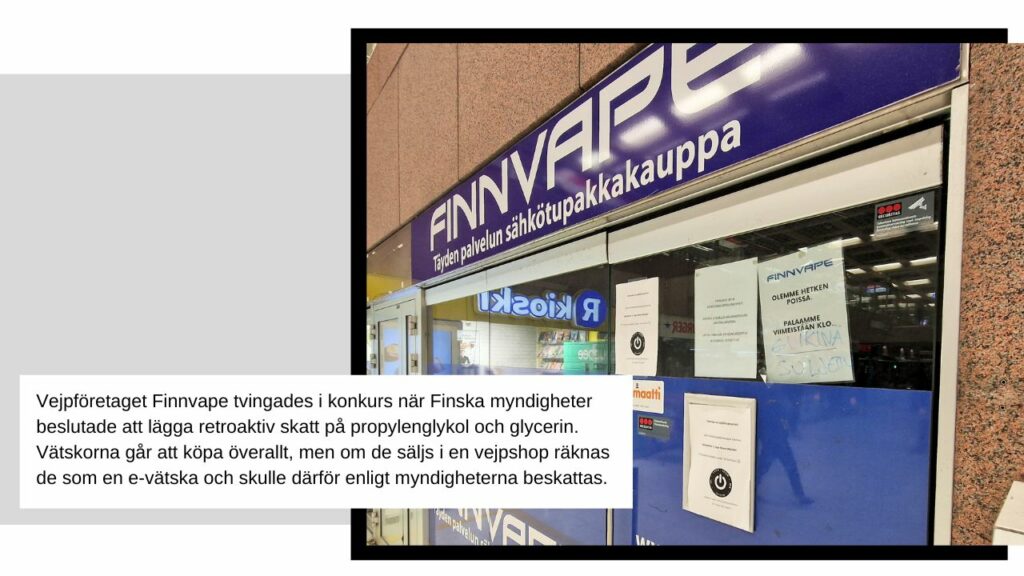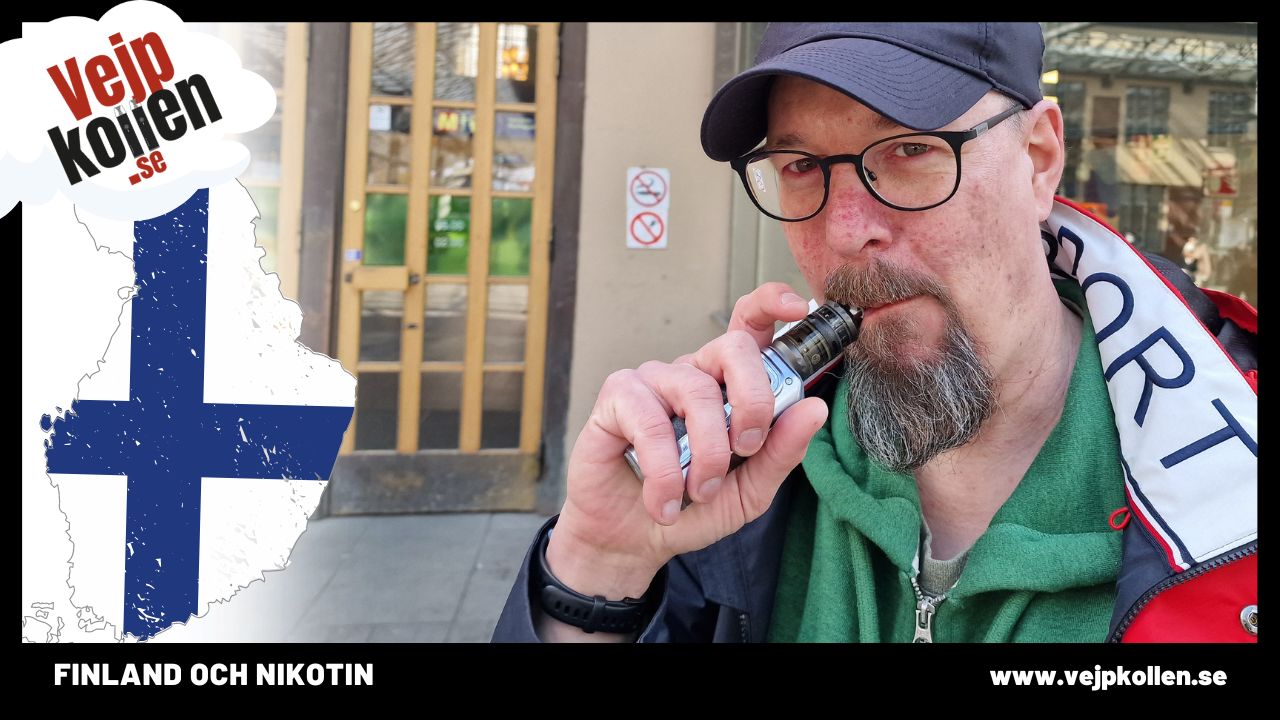Finland. Det nordiska land där flest människor röker, snus är olagligt och e-cigaretter regleras som om det vore cigaretter. Hur är det att vara vejpare i Finland? Går det att använda e-cigaretter i ett land vars regering gör allt för att förhindra det?
Vejpkollen har träffat Jari Ollikka, vejpare och talesperson för konsumentföreningen Vapers Finland.
Det första jag märker när jag ser mig omkring på stationen i Helsingfors är faktiskt doften av cigarettrök. Det kan vara en tillfällighet, men lite symboliskt ändå. Finland har sedan 2016 drivit en hård linje mot alla produkter som konkurrerar med cigarettfösäljningen. Inte helt oväntat har det påverkat statistiken. 12-14 procent av finnarna röker fortfarande, jämfört med 6 procent i Sverige och 10 procent i Norge.
Importerat snus och engångsmodeller
Snus är förbjudet att sälja enligt EU-lag, smaksättningar i e-cigaretter och e-vätska är kraftigt begränsade och nikotinpåsar har fram tills nyligen reglerats som läkemedel. Samtidigt är bruket av både snus och nikotinpåsar förhållandevis stort. Runt 9 procent av finnarna snusar, genom att importera från Sverige. Bruket av e-cigaretter, i synnerhet engångsmodeller, har ökat markant bland ungdomar – precis som i alla andra länder.
Vejpat i 12 år
Jari Ollikka rynkar lite på näsan när vi pratar om nikotinpåsar och engångsmodeller. Vi träffas på stationen den här kyliga vårdagen i Helsingfors. Är det verkligen så illa? Nä, det kan vara solen som sticker i ögonen också, tänker jag, Inte helt tydligt. Men ändå.
Han slutade röka 2011, berättar han. Och då var det med en liten ego penna och en stark nikotin juice från närbutiken – det var det senaste som e-cigaretttekniken kunde erbjuda då, för 12 år sedan.
“Jag pendlade lite mellan att röka och att vejpa i början. Men när jag väl hittade en bra vejp och en god smak så var jag färdig med cigaretterna” säger han.
Före EU-reglerna kom
Vejpprodukter var knappt reglerade någonstans i världen vid den tidpunkten och Finland var inget undantag. 2014 försökte EU förvandla e-vätska med nikotin till ett läkemedel. Kommissionen misslyckades, efter att en stor grupp användare fick gehör i parlamentet. Istället införlivade EU e-cigaretter och e-vätska det nya Tobaksdirektivet, TPD, ett regelverk som låg redo att bli implementerat 2016.
Smakförbud direkt
Det var då Finska anti-tobaksaktivister satte in stöten. Istället för att göra e-vätska till läkemedel (den ursprungliga planen i både EU och exempelvis Sverige) hade en “plan b” vuxit fram. Planen hette “smakförbud”. Och det stod snart klart att Finland skulle bli det första landet i EU att införa ett sådant förbud.
“När EU ställde upp sina TPD-regler blev det en aggressiv diskussion här i Finland. Och det var ju inte så trevligt för oss vejpare. Vi fick inte mycket att säga till om” minns Jari Ollikka.
Ska smaka som cigaretter
Resonemanget var att säkrare nikotinprodukter och rökavvänjning var något som läkemedelsföretagen skulle ha patent på – inte småföretagare och tobaksbolag. Och det räckte, tyckte en majoritet i Finska parlamentet. Så när TPD skulle implementeras i Finland valde man att samtidigt begränsa möjligheten att smaksätta e-vätskan i e-cigaretter med vad som helst. De skulle endast få säljas med ”karaktäristiska” smaker”. Och eftersom e-cigaretter, enligt resonemanget, egentligen bara var cigaretter som av någon anledning har ett “e” i prefixet, skulle även dessa smaka ”karaktäristiskt”.
”Som tobak, med andra ord. Fullkomligen logiskt i deras värld”, säger Jari Ollikka, med tydlig sarkasm.
Många blev rökare – igen
“Våra myndigheter har faktiskt aldrig definierat vad “en tobakssmak” är för något. Än mindre har man visat minsta intresse för att kontrollera de e-juicer som finns på marknaden idag. Det är som om det räcker att kalla något för “tobakssmak” så räcker det för kontrollanterna” säger Jari Ollikka när vi pratar över en vardagsbuffé på en restaurang i centrala Helsingfors.
“För oss som vejpade innebar det att alla e-juicer vi var vana vid försvann från butikerna. Många slutade vejpa och gick tillbaka till cigaretterna, såklart. Några kanske gick över till snus istället. Andra började blanda sina egna e-juicer” säger Jari Ollikka.
En ny marknad för smaker
Gör-det-själv lösningen blev snabbt grunden för en “ny” marknad i Finland. Basvätskorna, propylenglykol och glycerin började säljas i praktiska förpackningar, och smakämnen (flavorshots) och nikotin såldes var för sig.
“Smaksättningarna fick dock inte säljas eller marknadsföras “för att blanda i e-vätska”. För att undvika lagbrott fick de etiketter som “för bakning”” eller “mattillsatser”. Precis som i andra länder har vi nikotinshottar med 20 mg per milliliter. Vi köper allt separat och blandar ihop det hemma. Det är inte svårt – men jag tycker synd om de rökare som inte kan hoppa över från cigg till e-cigg utan att behöva krångla med allt det här” säger Jari Ollikka.
Två procent vejpar
Trots smakförbudet ligger andelen aktiva vejpare på runt två procent i Finland. Ungefär som i Sveirge. Men de var fler tidigare, konstaterar Jari Ollikka som varit aktiv i konsumentföreningen Vapers Finland länge.
“Vi var väldigt många fler innan alla förbud kom. Föreningen hade stöd från företagen, som gav rabatter åt medlemmarna. När det försvann minskade även intresset och vi tappade medlemmar.”
Förbud att köpa via nätet
Men det var egentligen inte smakförbudet som blev det stora dråpslaget för vejpning i Finland, konstaterar Jari Ollikka. Fler förbud väntade runt hörnet.
“Smaksättningen är ganska lätt att fixa själv, vi vejpare är ju innovativa. Det var däremot det omfattande förbudet att sälja vejpprodukter online som krånglade till det rejält. Tidigare kunde vi köpa våra grejer via internet, från andra länder eller från lokala vejpshoppar. När det försvann vet jag att det var droppen för många som vejpade. Hur skulle någon som inte bor i närheten av en vejpshop få tag på en ny mod, reservdelar och så vidare. Jag hörde folk som sa: “Jag kör tills det att modden går sönder, sen börjar jag nog röka igen”.
Nybörjare drabbades
Efter onlineförbudet återstod inte mycket på marknaden, i synnerhet inte för nybörjare, konstaterar Jari Ollikka.
“Jag köpte min första e-cigg i en närbutik. Men de säljer bara tobaksbolagens poddsystem nu. Vill du ha bra grejer måste du bo i närheten av en fysisk vejpbutik. Det fungerar i storstäderna, men inte på landsbygden” säger Jari Ollikka.
Utmanade förbudet
Trots detta har ett antal vejpshoppar hållit dörrarna öppna. Men även detta ser ut att förändras. I skrivande stund ska en domstol avgöra om det är ok för en vejpshop, det vill säga en butik som normalt säljer e-cigaretter och e-vätska, att marknadsföra smakaromer över huvud taget. Myndigheterna resonerar ganska krasst: OM vejpshoppen säljer smakaromer (som INTE är en så kallad “tobakssmak”) – så gör man det med intentionen att kunden ska göra e-vätska av den. Det skulle i så fall vara ett lagbrott. Det krångliga är givetvis att detta INTE skulle gälla om en “vanlig” butik säljer samma produkt.
“Vi hade väl alla väntat på att det här skulle hända till slut” säger Jari Ollikka. “De är verkligen ute efter att få bort vejpningen.”
Vejpshoppar stängde – skatt på VG
Samtidigt har skatteverket börjat skicka fakturor till vejpföretag som säljer basvätskorna propylenglykol och glycerin. Resonemanget är detsamma. Om vätskorna är tänkta att användas för att blanda e-vätska så ska de även beskattas som en e-vätska. Företaget FinnVape – som drivit målet om smaksättningarna till högsta juridiska instans – klarade inte av betala den enorma faktura som skatteverket skickade – retroaktiv skatt på tusentals liter basvätska. Konkursen kom snart efter.
“Finnvape var det företag som vågade utmana staten om aromerna. Och staten försatte dem i konkurs. Det känns ju inte helt ok” säger Jari Ollikka, lite sorgsen, men ändå inte helt uppgiven.

Specialistbutiker för aromer
Vi tar en kopp kaffe efter maten när han visar upp en hemsida han nyligen hittat . En specialistbutik för “aromer”.
“Baka småkakor, smaksätt som proffsen!” lyder rubriken. Ungefär.
Han flinar lite.
När jag tittar på sidan, på loggorna, varumärkerna, symbolerna på aromflaskorna förstår jag vad det handlar om: Det är kända e-juicemärken, presenterade som något du “blandar i kakan eller i drinken”. Det är givetvis inte smaker som är “gjorda” för att smaksätta drinkar – även om man tekniskt sett kan göra det. Det här är så här vejpare kan få tag på de smaker de vill ha i sin e-vätska.
Under bordet, med glimten i ögat, från en vejpare till en annan.
”De förstår inte vad de gör”
“Politiker i Finland visste, varken då eller nu, vad de lagstiftade om. Nu blev det så här istället. Problemet med systemet, som man faktiskt tvingar fram, är att en del användare kanske får för sig att det går att använda vilken arom som helst för att vejpa. Att det går bra att köpa vilken “kaksmak” som helst i affären och blanda e-juice på det. Det är bokstavligt talat livsfarligt, i synnerhet om aromerna är oljebaserade och inte vattenlösliga. En vejpshop skulle aldrig sälja såna produkter – men de är ju ute ur leken nu” säger Jari Ollikka.
Engångsvapes och tuggtobak
Motståndet mot e-cigaretter, men även alternativa nikotinprodukter som utmanar cigaretterna, är alltjämt kompakt i Finland. Inte desto mindre ökar bruket av produkterna lika mycket i Finland som i andra länder. Engångsmodelller är populära bland ungdomar, liksom det vita snuset, nikotinpåsar. Jag frågar om han märker av det?
“Nej faktiskt inte. Snuset är ju stort här i Finland sedan tidigare och vi får importera för eget bruk. Det går även att köpa “tuggtobak” – en variant på snus som måste tuggas lite innan den åker in under läppen. Men engångsmodeller ser man inte bland äldre särskilt ofta, och aldrig i butikerna såklart. Där finns det bara cigaretter.” säger Jari Ollikka.
Innan vi skiljs åt fragar jag om han ser någon ”ljusning” i framtiden. Han flinar igen.
“Nej, inte direkt” säger han och blåser ett moln över torget, mest för bildens skull.




